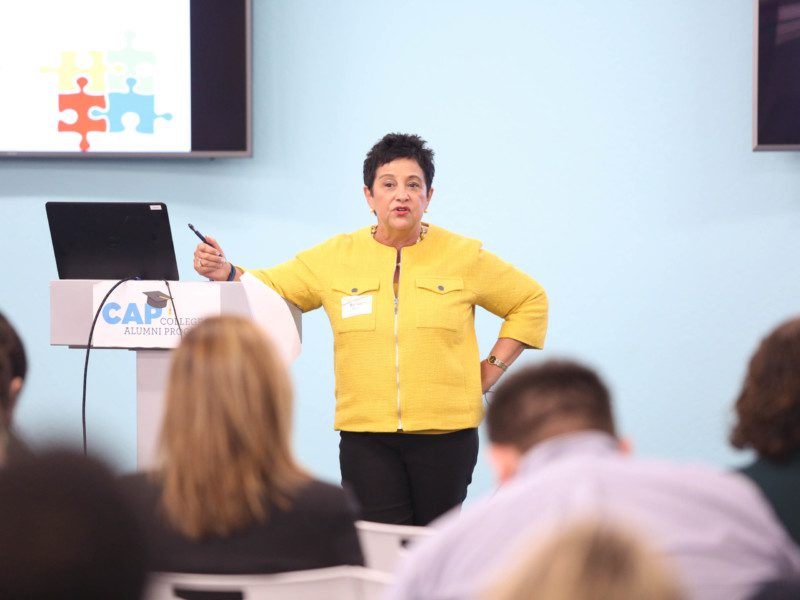Ways to Help Community College Students Succeed
by Amanda Medress

An interview with Esther Hugo, a featured speaker at the inaugural CAP College Success Institute, taking place May 20-21 in the San Francisco Bay Area.
For what types of students does community college make the most sense?
Community college makes the most sense for students who are concerned about the high cost of education. A lot of students see it as a way to get credits at a much lower price and then transfer to a four-year college or university. Also, it makes sense for students who aren’t ready to leave home and want to continue being commuter students. A lot of time students go to community college because they don’t know what they want to do and don’t want to make that huge investment of a 4-year college. We also see a lot of students of color—particularly Latino and African American students—enroll in community college because they can apply and they are admitted, and it seems like the least challenging way to continue their education.
What advice do you have for community college students hoping to transfer to a four-year school in a timely manner?
What students need to realize is that if they want to go to a community college in the fall, they should apply now. The earlier you apply, the easier it is to get your courses.
I recommend that students take a summer class. It gives them exposure to the campus earlier and keeps their student identity and academic momentum going. Even if they get on campus and take something that looks fun on the general education list, they grow more familiar with the campus and it’s not as overwhelming to them in the fall.
Something else students can do is to enroll as full-time students. The research says that’s better because it maximizes their connection and contact with faculty. Community colleges expect students to be full-time, which is usually 4 or 5 classes per semester.
After they apply, students can go to the career center if they’re not sure what their major will be and take career assessments. The research shows that students who take courses in their major, particularly students of color, are much more likely to transfer in two years than students who do not.
Something else I recommend students do is to get a job on campus, because a lot of students try to work full-time. It’s hard to be a full-time student and a full-time employee. People on campus know you’re a student and will be more understanding. Plus, that’s another person on campus who knows you and can write a good letter of recommendation if you need that for a scholarship or transfer application.
What can 4-year colleges and universities do to support transfer students?
They should realize community college students are different from freshmen, and they should treat them differently. A lot of community college students have families, family obligations, and jobs, so they need to market to them differently, really develop a savvy and responsive communication plan with text messages and more of an online presence. Also, just like they do for students who enter as freshmen, four-year colleges and universities should involve the transfer students’ parents in the whole process and provide orientations and parent weeks, covering topics such as how to study abroad as a transfer student. Some colleges and universities treat the transfer students like they have a scarlet letter T on their chest when they really should be rolling out the red carpet. A lot of transfer students do come with a confidence issue; an imposter syndrome. They might not feel like they really belong there.
We see the growing trend that more four-year colleges court transfer students because the student population declines, especially in the Midwest and Northeast. Those schools are looking for transfer students because they help them keep classes full and meet diversity targets.
How can we reduce the stigma around community college?
That’s something that can be addressed as early as high school. Students who are heading to community college should be recognized. We need to change the message – community college students won’t be paying as much money, but community college is still college and students still need to work hard. The four-year schools can really value and honor the students through different types of programs, such as orientations or preview days or scholarships. The system for transfer is really complicated. That’s something people don’t realize.
How would you like to see the college success conversation change in the next few years?
With the topic of college success, people are obsessed with the scandal about movie stars. But the real scandal is that our schools in California are underfunded, especially community colleges. I’d like to see more resources devoted to that. Given the nature of the population, those students need more resources and guidance than they get.
Cost is always a big issue. Students need to know what kind of money is available to them, whether it’s for community college or a four-year institution. The other part I would change is to make financial aid information a part of everything starting from middle school. Sometimes, families could have positioned themselves differently if they found out about it sooner. People who do recruitment for admissions also need to be conversant in financial aid.
Anything else you’d like to share?
The conversation also needs to change around undocumented students and dreamers. They always seem like they’re so vulnerable. A lot of families live in fear, I’d love to see something happen around that.
Want to learn more? Hear Esther Hugo speak at the inaugural CAP College Success Institute, taking place May 20-21 in the San Francisco Bay Area.
